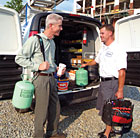
The days of carrying R-22 cannisters could be numbered as production cutbacks of the refrigerant continue.
If you believe global warming is for real, then part of the blame goes to leaking R-22 systems that were not repaired and charges of the refrigerant vented into the atmosphere. The industry did enough of that to upset the environmentalists and the United States Environmental Protection Agency (EPA) to first fine the industry for leaking and venting, and then taking away new supplies of the refrigerant all together.
If you blame just the environmentalists and regulators, then aim your first blame on the “greenies” and governments in Europe who started the whole “R-22 is an ozone depletion baddie” long before the industry did - and, in fact, pretty much influenced the U.S.
If you want to blame one person, blame former senator, former vice president, and now environmental activist Al Gore, who has been loudly bemoaning climate change for years, and won the Nobel Peace Prize, an Academy Award, and lots of converts in doing so.
The fact of the matter is, R-22 will no longer be charged in new equipment starting in 2010, the same year production of the refrigerant for any use will be significantly reduced. By 2020, there will be no production or importation of R-22.
All this can be traced to a production cap on HCFCs that began in 1996. In 2010, production will be only 25 percent of that cap. It will drop to 10 percent by 2015 and reach zero in 2020.
THE VENTING VILLIAN
Talk to most people involved in research related to environmental issues and they will point to the long-time common practice in the industry of venting refrigerants as the launching point for the eventual end of the production of new R-22.When asked “Why is R-22 dangerous?” Tameka Brown, product manager at Heatcraft Refrigeration Products, said, “When released into the atmosphere, R-22 is a hydrochlorofluorocarbon that damages the ozone layer that shields the earth from harmful UV rays.”
The EPA went into more graphic detail in its June 2008 update to the HVACR industry when it restated long-time concerns: “Excessive UV radiation damages biological systems and causes malignant melanoma and other skin cancers, cataracts, and harm to certain crops and marine organisms.”
The scientific community and virtually the entire HVACR industry has accepted the reality and negatives concerning ozone depletion. So how does one stop the damage and, in fact, reverse the process? It is a complicated answer, but one part of the equation concerns HCFCs such as R-22.
The Montreal Protocol of more than 20 years ago included caps on consumption of HCFCs as part of an effort “to reverse the course of stratospheric ozone depletion critical to human and environmental health worldwide.”
Veterans in the industry can recall the first fruits of the protocol were the requirement that technicians be certified to work with refrigerants. EPA certification was the hottest topic for several years.
THE ODP FACTOR
Initially, CFC refrigerants were first caught in the high ozone depletion potential (ODP) cross hairs due to concerns over what was considered especially high ODP, and were first phased out and at a more rapid pace than HCFCs were to face. In fact, HCFC-22 was tried for a time in low-temperature refrigeration applications that had once used CFC-502.But while HCFCs have lower ODP than CFCs, it wasn’t low enough, especially from the European mindset. In fact, while the United States is to end production of new equipment with HCFC-22 in 2010, that feat was accomplished in Europe in 2000.
The phaseout includes a variety of HCFCs of which R-22 is of primary interest to the HVACR industry. Formally, according to the EPA, as of Jan. 1, 2010, there is a “ban on production and import of R-22 except for ongoing servicing needs in equipment manufactured before Jan. 1, 2010.”
As of Jan. 1, 2015, there is a “ban on sale and use of all HCFCs except for use in chemical reactions where the HCFCs are completely used up in the process, reclaimed and recycled HCFCs, or for ongoing servicing needs in equipment manufactured before Jan. 1, 2010.” Jan. 1, 2020, officially marks the “ban on remaining production and import of R-22” while Jan. 1, 2030, is “the ban on remaining production and import of all other HCFCs.” In the latter case, about the only HVACR refrigerant fitting that category is R-123 used in some chiller applications.
THE SUPPLY ISSUE
The pace of the phaseout of R-22, the speed of manufacturers to convert HVAC equipment away from the refrigerant, and the willingness of contractors to recover it and either recycle it or submit it to reclamation services are not at all in sync. And that is raising questions about supplies.Said Craig Thomas of Arkema, “Up until 2010, we believe that the supply of R-22 will be similar to its current state” - meaning contractors should be able to get what they need. “The supply of 22 after 2010 is less certain.” This is due to the phaseout in new production of R-22 for the U.S. market.
“Government officials, along with many industry experts, believe there will be significant challenges for the R-22 supply chain in the very near future,” said Gordon McKinney of ICOR International. “Estimates are that the gap between what is being allocated by the government for R-22 production and importation falls short of what the service industry’s requirements will be by as much as 40 million pounds per year.”
For the record, the EPA is saying, “In 2015, R-22 needs will exceed the 2015 cap by more than 10,000 metric tons” unless there is a considerable improvement “in recovery and reuse” so as to “provide room under the cap to meet demand for all HCFCs.”
New supplies of R-22 are going, going, soon to be gone - but not without leaving a fair share of confusion and concerns.
Publication Date:02/09/2009


Report Abusive Comment